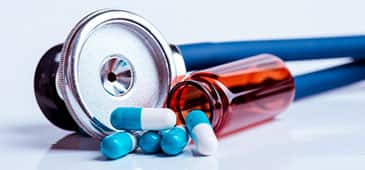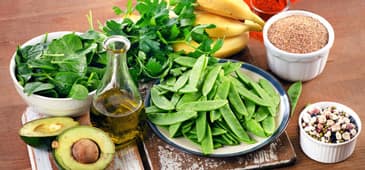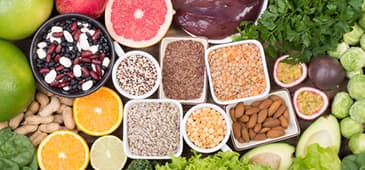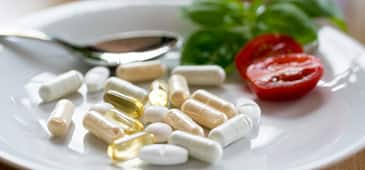
What's hot
What's hot
News flashes are posted here frequently to keep you up-to-date with the latest advances in health and longevity. We have an unparalleled track record of breaking stories about life extension advances.
Phosphatidylcholine could improve aspirin and other NSAIDs’ benefit in colorectal cancer
 May 30 2018. The May 2018 issue of the journal Oncology Letters suggests the addition of phosphatidylcholine, a compound present in lecithin, to nonsteroidal anti-inflammatory drugs for the prevention and treatment of colorectal cancer.
May 30 2018. The May 2018 issue of the journal Oncology Letters suggests the addition of phosphatidylcholine, a compound present in lecithin, to nonsteroidal anti-inflammatory drugs for the prevention and treatment of colorectal cancer.
“The chemopreventive activity of nonsteroidal anti-inflammatory drugs (NSAIDs), particularly aspirin, has been well demonstrated in preclinical and clinical studies,” write Lenard Lichtenberger, PhD, and colleagues at the University of Texas Health Science Center at Houston (UTHealth). “However, the primary side effect from this class of drug is gastrointestinal bleeding, which has limited the widespread use of NSAIDs for the prevention of cancer. The development of GI‑safer NSAIDs, which are associated with phosphatidylcholine may provide a solution to this therapeutic problem.”
Dr Lichtenberger’s team tested the effects of the NSAIDs aspirin and indomethacin in mouse colon cancer cells with or without phosphatidylcholine. They found that the addition of phosphatidylcholine boosted the NSAIDs’ ability to inhibit cancer cell growth in comparison with drug treatment alone. In mice with implanted cancer cells, aspirin or indomethacin combined with phosphatidylcholine was associated with less metastasis.
"Many cancers are inflammation based,” noted Dr Lichtenberger, who is the study's lead investigator and a professor of integrative biology and pharmacology at McGovern Medical School at UTHealth. “The anti-inflammatory drugs also have the potential use for cancer therapy."
However, he cautioned that when consumed regularly for many months NSAIDs can cause adverse effects. "The intestinal injury is worse than the stomach ulcers, for non-aspirin NSAIDs like indomethacin," Dr Lichtenberger stated.
"This is our latest preclinical study on the use of phosphatidylcholine to mitigate the side effects of using NSAIDs and protect against a number of cancers," he announced. "The results support the potential use of NSAIDs associated with phosphatidylcholine for the prevention and treatment of colorectal cancer."
—D Dye
Antioxidant supplement benefits CF patients
 May 25 2018. An article appearing April 24, 2018 in the American Journal of Respiratory and Critical Care Medicine documented a benefit for antioxidant supplementation among subjects with cystic fibrosis (CF), a genetic disease characterized by the production of thick mucus that impairs lung function. The current randomized trial found that patients who received antioxidants, which are poorly absorbed by CF patients, had a lower risk of respiratory infections, which are a common occurrence among CF patients.
May 25 2018. An article appearing April 24, 2018 in the American Journal of Respiratory and Critical Care Medicine documented a benefit for antioxidant supplementation among subjects with cystic fibrosis (CF), a genetic disease characterized by the production of thick mucus that impairs lung function. The current randomized trial found that patients who received antioxidants, which are poorly absorbed by CF patients, had a lower risk of respiratory infections, which are a common occurrence among CF patients.
The double-blind trial included 73 patients aged 10 years and older with CF and pancreatic insufficiency. Participants received an antioxidant-enriched nutritional supplement formulated for improved absorption or a control multivitamin lacking antioxidant enrichment for 16 weeks. Blood levels of the antioxidants beta-carotene, CoQ10, gamma-tocopherol and lutein, and other factors including markers of inflammation were measured after 4 weeks.
The researchers, from Children's Hospital Colorado and the University of Colorado School of Medicine observed a significant increase in antioxidant levels and lower markers of inflammation after 4 weeks among those who received the antioxidant-enriched formula in comparison with the control group. The antioxidant-treated group had a lower frequency of respiratory illnesses and half the risk of experiencing an initial pulmonary exacerbation that required antibiotic therapy compared to the other participants at 16 weeks.
"While more research certainly needs to be done to find a treatment that delivers a sustained anti-inflammatory effect, we believe the fact that this antioxidant supplement prolonged the time patients had before their first illness is meaningful,” stated first author Scott D. Sagel, MD, PhD, who is a pediatric pulmonologist at Children's Hospital Colorado and a professor of pediatrics at the University of Colorado School of Medicine. “It offers a simple, relatively inexpensive means for restoring and maintaining normal antioxidant levels in people who would otherwise have trouble doing so."
—D Dye
Vitamin D testing recommended for overweight individuals
 May 23 2018. The European Society of Endocrinology annual meeting (ECE 2018), held May 19 to 22 in Barcelona, was the site of a presentation concerning a study conducted by Dutch researchers which found a relationship between a greater amount of abdominal fat and lower levels of vitamin D. While previous research had uncovered an association between reduced vitamin D levels and obesity, no association had yet been determined with the type and location of body fat.
May 23 2018. The European Society of Endocrinology annual meeting (ECE 2018), held May 19 to 22 in Barcelona, was the site of a presentation concerning a study conducted by Dutch researchers which found a relationship between a greater amount of abdominal fat and lower levels of vitamin D. While previous research had uncovered an association between reduced vitamin D levels and obesity, no association had yet been determined with the type and location of body fat.
The current analysis included obese men and women between the ages of 45 and 65 years who participated in the Netherlands Epidemiology of Obesity study. Total body fat, abdominal subcutaneous adipose tissue, visceral adipose tissue (which surrounds the organs), liver fat and serum 25-hydroxyvitamin D levels were measured upon enrollment.
In women, greater total body fat was associated with lower concentrations of vitamin D. Increasing visceral adipose tissue was associated with declining vitamin D levels in both women and men. In men, having a higher amount of liver fat was associated with a lower level of 25-hydroxyvitamin D.
"Due to the observational nature of this study, we cannot draw a conclusion on the direction or cause of the association between obesity and vitamin D levels,” commented lead researcher Rachida Rafiq, MD, of the Department of Internal Medicine and Endocrinology at VU University Medical Center in Amsterdam. “However, this strong association may point to a possible role for vitamin D in abdominal fat storage and function."
"Although we did not measure vitamin D deficiency in our study, the strong relationship between increasing amounts of abdominal fat and lower levels of vitamin D suggests that individuals with larger waistlines are at a greater risk of developing deficiency, and should consider having their vitamin D levels checked," Dr Rafiq concluded.
—D Dye
Anthocyanin intake associated with lung protection
 May 21 2018. A presentation at the American Thoracic Society’s 2018 International Conference held May 18-23 revealed findings from a recent study that uncovered a protective association between greater intake of a class of flavonoids known as anthocyanins and better lung function maintenance. Anthocyanins are present in plant foods like grapes and berries, and have been investigated as a possible treatment for COPD.
May 21 2018. A presentation at the American Thoracic Society’s 2018 International Conference held May 18-23 revealed findings from a recent study that uncovered a protective association between greater intake of a class of flavonoids known as anthocyanins and better lung function maintenance. Anthocyanins are present in plant foods like grapes and berries, and have been investigated as a possible treatment for COPD.
"The epidemiological evidence on the association between flavonoids and lung function is very scant," noted lead study author Vanessa Garcia-Larsen, PhD, who is an assistant professor in the Department of International Health at the Johns Hopkins Bloomberg School of Public Health. "So, we wanted to investigate whether dietary intake and anthocyanins are associated with lung function decline in middle-age adults."
The current study included 463 participants in the second and third European Community Respiratory Health Surveys. Participants completed dietary questionnaires and received spirometry testing to evaluate lung function at enrollment in 2002 and at end of follow-up in 2012.
In comparison with subjects whose intake of anthocyanins was among the lowest 25%, those among the top 25% had a significantly slower rate of annual decline in FEV1 (a measure of the amount of air than can be forcefully exhaled in one second). Participants in the top 25% also had a slower annual rate of decline in FVC, which is the total amount of air than can be exhaled after a deep breath, as well as a slower rate of annual decline in the FEV1 to FVC ratio.
"Our study suggests that the general population could benefit from consuming more fruits rich in these flavonoids like berries, particularly those who have given up smoking or have never smoked,” Dr Garcia- Larsen commented. "For smokers, quitting remains the best thing they can do to protect their health."
—D Dye
High inactive matrix Gla protein levels suggest those who may benefit from vitamin K
 May 18 2018. A study reported in the May 2018 issue of American Journal of Hypertension found high levels of inactive matrix Gla protein (MGP) levels in African Americans who were receiving hemodialysis. Matrix Gla protein is an inhibitor of vascular calcification that depends on vitamin K for activation. Higher inactive MGP levels indicate decreased vascular vitamin K status and a greater risk of cardiovascular disease.
May 18 2018. A study reported in the May 2018 issue of American Journal of Hypertension found high levels of inactive matrix Gla protein (MGP) levels in African Americans who were receiving hemodialysis. Matrix Gla protein is an inhibitor of vascular calcification that depends on vitamin K for activation. Higher inactive MGP levels indicate decreased vascular vitamin K status and a greater risk of cardiovascular disease.
"We know that the lifespan of patients on hemodialysis is reduced, that cardiovascular disease accounts for about half their deaths and that vascular calcification is a key contributor," stated corresponding author Norman K. Pollock, of the Medical College of Georgia. "Key questions we want to answer include exactly how vascular calcification occurs in this very high-risk population of individuals and how we might better recognize, treat and ideally prevent these unhealthy changes to their blood vessels."
The study included 37 African American hemodialysis patients and an equal number of control subjects matched for race and age. Inactive MGP levels were measured in the plasma of both groups. Carotid-femoral pulse wave velocity and brachial artery flow-mediated dilation measurements evaluated endothelial function among those who were receiving hemodialysis.
Average inactive MGP levels were 5.6 times higher among the hemodialysis group than the control group. In hemodialysis patients, inactive MGP was were associated with pulse wave velocity, indicating greater endothelial dysfunction. While it is unknown why these patients had higher levels of inactive MGP, they may simply need more vitamin K, Dr Pollock remarked.
According to first author Mary Ellen Fain, identifying those who have high levels of inactive MGP may help determine who could benefit most from vitamin K supplementation. The researchers plan to evaluate the effects of vitamin K supplements among adult kidney disease patients.
—D Dye
Insufficient vitamin D levels linked with nonalcoholic fatty liver disease in children
 May 16 2018. Research reported on May 14, 2018 in Pediatric Obesity documents an association between vitamin D-related genetic variants, insufficient vitamin D levels and nonalcoholic fatty liver disease (NAFLD) in children. The study is the first to uncover an association between genetic variations in vitamin D’s metabolic pathway in children and liver damage severity.
May 16 2018. Research reported on May 14, 2018 in Pediatric Obesity documents an association between vitamin D-related genetic variants, insufficient vitamin D levels and nonalcoholic fatty liver disease (NAFLD) in children. The study is the first to uncover an association between genetic variations in vitamin D’s metabolic pathway in children and liver damage severity.
The study included 103 children residing in the UK who were diagnosed with NAFLD. 25-hydroxyvitamin D levels assessed during a one-year period revealed that the majority of the children had deficient levels of less than 10 nanograms per milliliter (ng/mL) or insufficient levels of less than 20 ng/mL. Participants’ winter levels were lower than those measured during spring, summer and autumn. Variations in two vitamin D-related genes and the vitamin D receptor were associated with increased liver fat and one genetic variant was associated with greater liver inflammation, as ascertained by biopsy.
“Children with NAFLD in the UK have particularly low winter vitamin D status, with vitamin D insufficiency prevalent throughout the year,” the authors conclude. “Polymorphisms in the vitamin D metabolic pathway are associated with histological severity of pediatric NAFLD.”
"Despite the high prevalence of non-alcoholic fatty liver disease, thus far lifestyle change is the only proven effective treatment for those diagnosed,” commented coauthor Bernadette Moore of the School of Food Science and Nutrition at the University of Leeds. “However, the lack of understanding regarding the disease's molecular pathogenesis makes it very difficult to identify patients who are most likely to suffer disease progression and therefore to benefit from intervention.”
"Our research hopes to add to the growing body of work that would make it easier to identify those at risk of progression, allowing for more targeted individualized therapy."
—D Dye
Mediterranean, DASH diets associated with lower risk of hearing loss
 May 14 2018. An article appearing on May 11, 2018 in the Journal of Nutrition reports the finding of a protective effect for a Mediterranean or DASH diet against hearing loss in large study of women.
May 14 2018. An article appearing on May 11, 2018 in the Journal of Nutrition reports the finding of a protective effect for a Mediterranean or DASH diet against hearing loss in large study of women.
The current investigation included 81,818 women who were between the ages of 27 and 44 years old upon enrollment in the Nurses’ Health Study II. Dietary questionnaires administered every four years provided data that was used to determine adherence to the Alternate Mediterranean diet (characterized by a greater intake of olive oil, grains, vegetables, legumes, fruit, nuts and fish, and moderate alcohol intake), the Dietary Approaches to Stop Hypertension (DASH, which is high in vegetables, fruit and low-fat dairy products and low in sodium) and the Alternative Healthy Eating Index 2010 (which combines some features of both diets).
The subjects were followed for 22 years, during which 2,306 cases of moderate or worse hearing loss were reported. Women whose Alternate Mediterranean diet scores were among the highest 20% had a 30% lower risk of hearing loss than those whose scores were among the lowest 20%. A similar reduction in risk was observed in association with the DASH diet. A subgroup analysis of 33,102 women for whom more information was available concerning their hearing found even greater protective effects for both diets as well as a benefit for the Alternative Healthy Eating Index.
"Interestingly, we observed that those following an overall healthy diet had a lower risk of moderate or worse hearing loss," stated first author Sharon Curhan, MD, who is an epidemiologist in the Channing Division of Network Medicine at Brigham and Women’s Hospital. "Eating well contributes to overall good health, and it may also be helpful in reducing the risk of hearing loss."
—D Dye
Active dogs need antioxidants, too
 May 11 2018. Vigorous physical activity, such as that engaged in by exercising humans, may result in an increased requirement for dietary antioxidants to protect against oxidative stress. Turns out the same may be true for dogs.
May 11 2018. Vigorous physical activity, such as that engaged in by exercising humans, may result in an increased requirement for dietary antioxidants to protect against oxidative stress. Turns out the same may be true for dogs.
In a study reported in the April 3, 2018 issue of the Journal of Animal Science, American foxhounds were given a high performance commercial diet or a similar diet with the addition of the antioxidants vitamin C, vitamin E, lutein, the amino acid taurine, and zinc. During the 7-month study, the dogs went on 2 to 3 hunts per week that were 2 to 5 hours long. "We think of it as unstructured endurance exercise,” commented corresponding author Kelly Swanson, who is a Professor in the Division of Nutritional Sciences at the University of Illinois. “They're not running the entire time. They might stop to sniff or go more slowly to pick up a scent."
Blood samples collected prior to and during the study were analyzed for oxidative stress markers and blood metabolites. It was observed that dogs that received the commercial diet experienced declines in vitamin E and taurine, while levels of these nutrients were maintained at or above baseline levels among animals that received the antioxidant-supplemented diet.
"We hypothesized that dogs fed the test diet would have a lower concentration of oxidative stress markers and improved performance compared to the dogs fed the commercial diet," Dr Swanson commented. "It turns out performance wasn't affected by diet, but the test diet did improve indirect measures of oxidative stress. Therefore, improved performance may be expected with more strenuous exercise when metabolic demands are higher."
"We can conclude that athletic dogs may benefit from supplementation of vitamin E and taurine to minimize oxidation and maintain taurine status," he added.
—D Dye
Fish oil, vitamin K reduce arthritis pain
 May 9 2018. A review appearing on April 17, 2018 in the journal Rheumatology suggests that fish oil, vitamin K and, among those who are overweight, a calorie restricted diet could help decrease pain in people with osteoarthritis.
May 9 2018. A review appearing on April 17, 2018 in the journal Rheumatology suggests that fish oil, vitamin K and, among those who are overweight, a calorie restricted diet could help decrease pain in people with osteoarthritis.
The review, which has been called the largest and most up to date of its kind, analyzed 68 studies that examined the association between diet and osteoarthritis self-management. Authors Sally Thomas and her colleagues at the University of Surrey in Guildford, England, concluded that a gram of fish oil daily, which provides the body with omega 3 fatty acids, can alleviate inflammation, thereby relieving pain in addition to supporting cardiovascular health. An increase in vitamin K, provided by green vegetables or supplements, can also be helpful, as can ensuring adequate intake of antioxidants, including vitamins A, C and E.
For those who are overweight, restricting the number of calories consumed can improve body composition to reduce strain on the joints. Obesity is also associated with low-grade, systemic inflammation that damages joints and other tissues.
"The importance of a good diet and regular exercise should never be underestimated,” concluded lead researcher and University of Surrey Professor of Nutritional Medicine Margaret Rayman.
"A combination of good diet and regular exercise are necessary to keep joints healthy; you can't have healthy joints with just one, you need both,” added coauthor Ali Mobasheri, who is a Professor of Musculoskeletal Physiology at the University of Surrey. "Lifestyle should also be considered when attempting to reduce the pain of osteoarthritis. Patients can't expect miracles with dietary interventions if they are overweight and drink or smoke heavily. Evidence shows that smoking and heavy drinking negatively affects body energy metabolism and inflammatory markers in the liver which may promote inflammation and disease in the body."
—D Dye
Folic acid lowers chances of stroke in high risk adults
 May 7 2018. The May 15, 2018 issue of the Journal of the American College of Cardiology found a protective effect for folic acid among men and women with hypertension, elevated homocysteine and low platelet counts.
May 7 2018. The May 15, 2018 issue of the Journal of the American College of Cardiology found a protective effect for folic acid among men and women with hypertension, elevated homocysteine and low platelet counts.
The study included 10,789 participants in the China Stroke Primary Prevention Trial (CSPPT) who had high blood pressure or were using antihypertensive drugs. Earlier research involving CSPPT participants had shown that folic acid could reduce first stroke risk among hypertensive adults by 21%, by lowering homocysteine.
Subjects received the blood pressure drug enalapril with or without 800 micrograms folic acid per day. Among those who received enalapril alone, the lowest rate of first stroke during 4.2 years of follow-up occurred among those with a high platelet count and low homocysteine levels, while the highest rate occurred among those with low platelet counts and high homocysteine levels. Treatment with folic acid resulted in a 73% reduction in the risk of a first stroke among participants with low platelet counts and high homocysteine levels while no significant effect for the vitamin against stroke was observed in the low risk group.
"Our analysis has shown that baseline low platelet count and elevated homocysteine can jointly increase the risk of first stroke," stated senior author Yong Huo, MD. "If the findings are further confirmed by prospective trials, we can raise the prospect that we can identify patients at high risk of developing first stroke by measuring both platelet and homocysteine, and we can remarkably lower stroke risk among this subgroup of patients with folic acid--a simple, safe and inexpensive treatment."
"The widespread belief that B vitamins do not reduce the risk of stroke is mistaken,” commented J. David Spence, MD, in an accompanying editorial. “This study not only invited confirmation of the benefit of B vitamins, but opens the door to wider applications."
—D Dye
Fasting helps preserve intestinal stem cell regeneration
 May 4 2018. Research reported in the May 3, 2018 issue of Cell Stem Cell revealed a positive effect for fasting in the reduction of the age-related decrease in intestinal stem cell regeneration. "Intestinal stem cells are the workhorses of the intestine that give rise to more stem cells and to all of the various differentiated cell types of the intestine,” explained senior author and Massachusetts Institute of Technology assistant professor of biology Ömer Yilmaz. “Notably, during aging, intestinal stem function declines, which impairs the ability of the intestine to repair itself after damage. In this line of investigation, we focused on understanding how a 24-hour fast enhances the function of young and old intestinal stem cells."
May 4 2018. Research reported in the May 3, 2018 issue of Cell Stem Cell revealed a positive effect for fasting in the reduction of the age-related decrease in intestinal stem cell regeneration. "Intestinal stem cells are the workhorses of the intestine that give rise to more stem cells and to all of the various differentiated cell types of the intestine,” explained senior author and Massachusetts Institute of Technology assistant professor of biology Ömer Yilmaz. “Notably, during aging, intestinal stem function declines, which impairs the ability of the intestine to repair itself after damage. In this line of investigation, we focused on understanding how a 24-hour fast enhances the function of young and old intestinal stem cells."
"It was very obvious that fasting had this really immense effect on the ability of intestinal crypts to form more organoids, which is stem-cell-driven," observed first author Maria Mihaylova, of MIT and Howard Hughes Medical Institute. "This was something that we saw in both the young mice and the aged mice, and we really wanted to understand the molecular mechanisms driving this."
"This study provided evidence that fasting induces a metabolic switch in the intestinal stem cells, from utilizing carbohydrates to burning fat," reported coauthor David Sabatini, also of MIT. "Interestingly, switching these cells to fatty acid oxidation enhanced their function significantly. Pharmacological targeting of this pathway may provide a therapeutic opportunity to improve tissue homeostasis in age-associated pathologies."
"Fasting has many effects in the intestine, which include boosting regeneration as well as potential uses in any type of ailment that impinges on the intestine, such as infections or cancers," Dr Yilmaz concluded. "Understanding how fasting improves overall health, including the role of adult stem cells in intestinal regeneration, in repair, and in aging, is a fundamental interest of my laboratory."
—D Dye
High dose vitamin D could improve malnourished children’s future
 May 2 2018. The May 2018 issue of the American Journal of Clinical Nutrition included a report of recent randomized trial findings whichsuggest that treating malnourished children with high dose vitamin D supplements could improve weight gain, and language and motor skill development--all of which are adversely impacted by poor nutrition.
May 2 2018. The May 2018 issue of the American Journal of Clinical Nutrition included a report of recent randomized trial findings whichsuggest that treating malnourished children with high dose vitamin D supplements could improve weight gain, and language and motor skill development--all of which are adversely impacted by poor nutrition.
The trial included 185 severely malnourished Pakistani children between the ages of 6 and 58 months who were treated with a high energy diet for 8 weeks. At 2 and 4 weeks the children received 200,000 international units vitamin D3 or a placebo. At the end of the trial, children who had received vitamin D gained an average of 0.26 kilograms more than those in the placebo group. The vitamin D-treated group also had fewer members with delayed motor, language and global development.
"High-dose vitamin D significantly boosted weight gain in malnourished children,” concluded lead author Dr Javeria Saleem of University of the Punjab and Queen Mary University of London. “This could be a game-changer in the management of severe acute malnutrition, which affects 20 million children worldwide."
"Our findings could be a great help to the Health Ministry of Pakistan in dealing with the issue of malnutrition," added coauthor Dr Rubeena Zakar of University of the Punjab.
"This is the first clinical trial in humans to show that vitamin D can affect brain development, lending weight to the idea that vitamin D has important effects on the central nervous system,” announced senior author Adrian Martineau of Queen Mary University of London. "Further trials in other settings are now needed to see whether our findings can be reproduced elsewhere. We are also planning a larger trial in Pakistan to investigate whether high-dose vitamin D could reduce mortality in children with severe malnutrition."
—D Dye
